Energy and Environmental Impact of the Promotion of Battery Electric Vehicles in the Context of Banning Gasoline Vehicle Sales †
Abstract
:1. Introduction
2. Materials and Methods
2.1. LCA Method
2.2. The Calculation of the Life Cycle GHGEI and FECI of BEVs and GVs
2.3. Population Growth Model and Simulation of Automobile Market Scale
2.4. The Annual FE Consumption and GHG Emissions from China’s Automobile Market
3. Results
3.1. The Life Cycle GHGEI and FECI of BEV and GV
3.2. Market Scale of BEVs and GVs
3.3. The ESER Effect of China’s BEVs Promotion under Different BGVS Scenarios
4. Discussion
Author Contributions
Funding
Data Availability Statement
Conflicts of Interest
Appendix A
| Ecoinvent Unit Process | Unit | Value | |
|---|---|---|---|
| Vehicle manufacture | Glider | kg | 1046.5 |
| Powertrain | kg | 103.5 | |
| Lithium batteries | kg | 285.6 | |
| Vehicle maintenance | Maintenance of passenger cars (BEVs) | p | 1 |
| Scrapping and disposal | Dismantling of used BEVs | p | 1 |
| Treatment of used gliders | kg | 1046.5 | |
| Treatment of used powertrains for electric passenger cars | kg | 103.5 | |
| Treatment of used lithium batteries | kg | 285.6 |
Appendix B
| Ecoinvent Unit Process | Unit | Value | |
|---|---|---|---|
| Vehicle manufacture | Glider | kg | 913.16 |
| Internal combustion engine | kg | 320.84 | |
| Vehicle maintenance | Maintenance of passenger cars (GVs) | p | 1 |
| Scrapping and disposal | Treatment of used gliders | kg | 913.16 |
| Treatment of used internal combustion engines | kg | 320.84 | |
| Dismantling of used passenger cars with internal combustion engines | p | 1 |
Appendix C
| Material | Mass (Unit: kg) | FE Consumption (Unit: MJ/kg) | GHG Emissions (Unit: kg CO2-eq/kg) | |
|---|---|---|---|---|
| Electrode active material | Graphite | 43.03 | 15.02 | 272.30 |
| NMC | 68.99 | 31.48 | 448.59 | |
| Electrolyte material | Dimethyl carbonate | 11.86 | 1.31 | 47.60 |
| Ethylene carbonate | 11.90 | 1.65 | 34.08 | |
| Lithium hexafluorophosphate | 4.46 | 26.43 | 360.13 | |
| Electrode supportive material | Cu foil | 22.22 | 3.01 | 45.09 |
| N-Methyl-2-pyrrolidone | 92.91 | 2.48 | 82.09 | |
| Al foil | 9.56 | 17.87 | 288.16 | |
| Polyvinylidene fluoride | 5.80 | 11.47 | 183.21 | |
| Separator | Polyethylene membrane | 3.08 | 8.84 | 149.22 |
| Packaging | Al housing | 4.12 | 15.75 | 254.35 |
| Cu tab | 7.51 | 3.42 | 27.88 |
Appendix D
| Year | Vehicles (in Millions) | Year | Vehicles (in Millions) |
|---|---|---|---|
| 1985 | 0.2849 | 2004 | 14.8166 |
| 1986 | 0.3471 | 2005 | 18.4807 |
| 1987 | 0.4229 | 2006 | 23.3332 |
| 1988 | 0.6042 | 2007 | 28.7622 |
| 1989 | 0.7312 | 2008 | 35.0139 |
| 1990 | 0.8162 | 2009 | 45.7491 |
| 1991 | 0.9604 | 2010 | 59.3871 |
| 1992 | 1.1820 | 2011 | 73.2679 |
| 1993 | 1.5577 | 2012 | 88.3860 |
| 1994 | 2.0542 | 2013 | 105.0168 |
| 1995 | 2.4996 | 2014 | 123.3936 |
| 1996 | 2.8967 | 2015 | 140.9910 |
| 1997 | 3.5836 | 2016 | 165.9900 |
| 1998 | 4.2365 | 2017 | 184.6954 |
| 1999 | 5.3388 | 2018 | 205.5540 |
| 2000 | 6.2533 | 2019 | 226.3543 |
| 2001 | 7.7078 | 2020 | 243.9336 |
| 2002 | 9.6898 | 2021 | 262.4640 |
| 2003 | 12.1923 |
References
- Schneider, E. Germany’s Industrial strategy 2030, EU competition policy and the Crisis of New Constitutionalism. (Geo-)political economy of a contested paradigm shift. New Political Econ. 2022, 1–18. [Google Scholar] [CrossRef]
- Umar, M.; Ji, X.; Kirikkaleli, D.; Alola, A.A. The imperativeness of environmental quality in the United States transportation sector amidst biomass-fossil energy consumption and growth. J. Clean. Prod. 2021, 285, 124863. [Google Scholar] [CrossRef]
- Kopelias, P.; Demiridi, E.; Vogiatzis, K.; Skabardonis, A.; Zafiropoulou, V. Connected & autonomous vehicles—Environmental impacts—A review. Sci. Total Environ. 2020, 712, 135237. [Google Scholar] [CrossRef] [PubMed]
- Simsek, Y.; Lorca, Á.; Urmee, T.; Bahri, P.A.; Escobar, R. Review and assessment of energy policy developments in Chile. Energy Policy 2019, 127, 87–101. [Google Scholar] [CrossRef]
- Dzienis, A.M.; McCaleb, A. Motives behind Sino-Japanese strategic alliances in the new energy vehicles sector in the age of the Belt and Road Initiative. Asia Pac. Bus. Rev. 2022, 1–26. [Google Scholar] [CrossRef]
- Ahmadi, P. Environmental impacts and behavioral drivers of deep decarbonization for transportation through electric vehicles. J. Clean. Prod. 2019, 225, 1209–1219. [Google Scholar] [CrossRef]
- Conway, G.; Joshi, A.; Leach, F.; García, A.; Senecal, P.K. A review of current and future powertrain technologies and trends in 2020. Transp. Eng. 2021, 5, 100080. [Google Scholar] [CrossRef]
- Li, X.; Xiao, X.; Guo, H. A novel grey Bass extended model considering price factors for the demand forecasting of European new energy vehicles. Neural Comput. Appl. 2022, 34, 11521–11537. [Google Scholar] [CrossRef]
- Dahlgren, S. Biogas-based fuels as renewable energy in the transport sector: An overview of the potential of using CBG, LBG and other vehicle fuels produced from biogas. Biofuels 2022, 13, 587–599. [Google Scholar] [CrossRef]
- Sorlei, I.-S.; Bizon, N.; Thounthong, P.; Varlam, M.; Carcadea, E.; Culcer, M.; Iliescu, M.; Raceanu, M. Fuel Cell Electric Vehicles—A Brief Review of Current Topologies and Energy Management Strategies. Energies 2021, 14, 252. [Google Scholar] [CrossRef]
- Al-Enazi, A.; Okonkwo, E.C.; Bicer, Y.; Al-Ansari, T. A review of cleaner alternative fuels for maritime transportation. Energy Rep. 2021, 7, 1962–1985. [Google Scholar] [CrossRef]
- Vinoth Kanna, I.; Paturu, P. A study of hydrogen as an alternative fuel. Int. J. Ambient Energy 2020, 41, 1433–1436. [Google Scholar] [CrossRef]
- Wang, K.-H.; Su, C.-W.; Umar, M. Geopolitical risk and crude oil security: A Chinese perspective. Energy 2021, 219, 119555. [Google Scholar] [CrossRef]
- Pan, X.; Wang, L.; Dai, J.; Zhang, Q.; Peng, T.; Chen, W. Analysis of China’s oil and gas consumption under different scenarios toward 2050: An integrated modeling. Energy 2020, 195, 116991. [Google Scholar] [CrossRef]
- Wang, H.; Li, S. Asymmetric volatility spillovers between crude oil and China’s financial markets. Energy 2021, 233, 121168. [Google Scholar] [CrossRef]
- Wang, Y.; Yu, H.; Zhang, H.; Chen, T. Non-linear analysis of effects of energy consumption on economic growth in China: Role of real exchange rate. Econ. Model. 2021, 104, 105623. [Google Scholar] [CrossRef]
- National Bureau of Statistics of China. China Energy Statistical Yearbook 2021; National Bureau of Statistics of China: Beijing, China, 2022. [Google Scholar]
- Zhao, W. China’s goal of achieving carbon neutrality before 2060: Experts explain how. Natl. Sci. Rev. 2022, 9, nwac115. [Google Scholar] [CrossRef]
- Li, W.; Zhang, S.; Lu, C. Exploration of China’s net CO2 emissions evolutionary pathways by 2060 in the context of carbon neutrality. Sci. Total Environ. 2022, 831, 154909. [Google Scholar] [CrossRef]
- Fang, K.; Li, C.; Tang, Y.; He, J.; Song, J. China’s pathways to peak carbon emissions: New insights from various industrial sectors. Appl. Energy 2022, 306, 118039. [Google Scholar] [CrossRef]
- Peng, T.; Yuan, Z.; Ren, L.; Ou, X. Low-carbon development path of China’s transportation sector under carbon neutrality target. J. Automot. Eng. 2022, 4, 351–359. [Google Scholar]
- Zhao, F.; Liu, X.; Zhang, H.; Liu, Z. Automobile Industry under China’s Carbon Peaking and Carbon Neutrality Goals: Challenges, Opportunities, and Coping Strategies. J. Adv. Transp. 2022, 2022, 5834707. [Google Scholar] [CrossRef]
- Hepburn, C.; Qi, Y.; Stern, N.; Ward, B.; Xie, C.; Zenghelis, D. Towards carbon neutrality and China’s 14th Five-Year Plan: Clean energy transition, sustainable urban development, and investment priorities. Environ. Sci. Ecotechnology 2021, 8, 100130. [Google Scholar] [CrossRef]
- Tang, W.; Wu, P.; Zhang, Y.; Cao, X. Analysis on the Current Situation and Development Trend of China’s Electrification Level and Electric Energy Substitution under the Background of Carbon Neutral. IOP Conf. Ser. Earth Environ. Sci. 2021, 661, 12019. [Google Scholar] [CrossRef]
- Wang, X.; Huang, L.; Daim, T.; Li, X.; Li, Z. Evaluation of China’s new energy vehicle policy texts with quantitative and qualitative analysis. Technol. Soc. 2021, 67, 101770. [Google Scholar] [CrossRef]
- Li, J.; Jiao, J.; Xu, Y.; Chen, C. Impact of the latent topics of policy documents on the promotion of new energy vehicles: Empirical evidence from Chinese cities. Sustain. Prod. Consum. 2021, 28, 637–647. [Google Scholar] [CrossRef]
- Dong, F.; Liu, Y. Policy evolution and effect evaluation of new-energy vehicle industry in China. Resour. Policy 2020, 67, 101655. [Google Scholar] [CrossRef]
- National Bureau of Statistics of China. 2021 Statistical Bulletin on National Economic and Social Development; National Bureau of Statistics of China: Beijing, China, 2022. [Google Scholar]
- Bauer, G.S.; Zheng, C.; Shaheen, S.; Kammen, D.M. Leveraging Big Data and Coordinated Charging for Effective Taxi Fleet Electrification: The 100% EV Conversion of Shenzhen, China. IEEE Trans. Intell. Transp. Syst. 2022, 23, 10343–10353. [Google Scholar] [CrossRef]
- Feng, Y.; Yang, J.; Dong, Z. Fuel Selections for Electrified Vehicles: A Well-to-Wheel Analysis. World Electr. Veh. J. 2021, 12, 151. [Google Scholar] [CrossRef]
- National Bureau of Statistics of China. China Statistical Yearbook 2021; National Bureau of Statistics of China: Beijing, China, 2022. [Google Scholar]
- Cai, S.; Kirtley, J.L.; Lee, C.H.T. Critical Review of Direct-Drive Electrical Machine Systems for Electric and Hybrid Electric Vehicles. IEEE Trans. Energy Convers. 2022, 1–12. [Google Scholar] [CrossRef]
- Asghar, R.; Rehman, F.; Ullah, Z.; Qamar, A.; Ullah, K.; Iqbal, K.; Aman, A.; Nawaz, A.A. Electric vehicles and key adaptation challenges and prospects in Pakistan: A comprehensive review. J. Clean. Prod. 2021, 278, 123375. [Google Scholar] [CrossRef]
- Lin, B.; Shi, L. Do environmental quality and policy changes affect the evolution of consumers’ intentions to buy new energy vehicles. Appl. Energy 2022, 310, 118582. [Google Scholar] [CrossRef]
- Jiaqi, L.I.; Xiaoyuan, X.U.; Zheng, Y. A Review of Coupled Electricity and Hydrogen Energy System with Transportation System Under the Background of Large-Scale New Energy Vehicles Access. J. Shanghai Jiaotong Univ. 2022, 56, 253–266. [Google Scholar]
- König, A.; Nicoletti, L.; Schröder, D.; Wolff, S.; Waclaw, A.; Lienkamp, M. An Overview of Parameter and Cost for Battery Electric Vehicles. World Electr. Veh. J. 2021, 12, 21. [Google Scholar] [CrossRef]
- Alsharif, A.; Tan, C.W.; Ayop, R.; Dobi, A.; Lau, K.Y. A comprehensive review of energy management strategy in Vehicle-to-Grid technology integrated with renewable energy sources. Sustain. Energy Technol. Assess. 2021, 47, 101439. [Google Scholar] [CrossRef]
- Previti, U.; Brusca, S.; Galvagno, A.; Famoso, F. Influence of Energy Management System Control Strategies on the Battery State of Health in Hybrid Electric Vehicles. Sustainability 2022, 14, 12411. [Google Scholar] [CrossRef]
- Wang, Y.; Jiao, X.; Sun, Z.; Li, P. Energy Management Strategy in Consideration of Battery Health for PHEV via Stochastic Control and Particle Swarm Optimization Algorithm. Energies 2017, 10, 1894. [Google Scholar] [CrossRef] [Green Version]
- Zeng, B.; Li, H.; Mao, C.; Wu, Y. Modeling, prediction and analysis of new energy vehicle sales in China using a variable-structure grey model. Expert Syst. Appl. 2023, 213, 118879. [Google Scholar] [CrossRef]
- He, L.-Y.; Pei, L.-L.; Yang, Y.-H. An optimised grey buffer operator for forecasting the production and sales of new energy vehicles in China. Sci. Total Environ. 2020, 704, 135321. [Google Scholar] [CrossRef]
- Coltura Gasoline Vehicle Phaseout Advances around the World. Available online: https://www.coltura.org/world-gasoline-phaseouts (accessed on 5 September 2022).
- ISO International Standard 14044; Environmental Management Life Cycle Assessment-Requirements and Guidelines. ISO: Geneva, Switzerland, 2006.
- ISO International Standard 14040; Environmental Management-Life Cycle Assessment. Principles and Framework. ISO: Geneva, Switzerland, 2006.
- China Automobile Dealers Association. 2021 China Automobile Market Yearbook; China Automobile Dealers Association: Beijing, China, 2021. [Google Scholar]
- Sun, S.; Ertz, M. Environmental impact of mutualized mobility: Evidence from a life cycle perspective. Sci. Total Environ. 2021, 772, 145014. [Google Scholar] [CrossRef]
- Yang, L.; Yu, B.; Yang, B.; Chen, H.; Malima, G.; Wei, Y.-M. Life cycle environmental assessment of electric and internal combustion engine vehicles in China. J. Clean. Prod. 2021, 285, 124899. [Google Scholar] [CrossRef]
- Ding, N.; Liu, J.; Yang, J.; Yang, D. Comparative life cycle assessment of regional electricity supplies in China. Resour. Conserv. Recycl. 2017, 119, 47–59. [Google Scholar] [CrossRef]
- Qiao, Q.; Zhao, F.; Liu, Z.; He, X.; Hao, H. Life cycle greenhouse gas emissions of Electric Vehicles in China: Combining the vehicle cycle and fuel cycle. Energy 2019, 177, 222–233. [Google Scholar] [CrossRef]
- China National Energy Administration. China Electric Power Statistical Yearbook 2021; China Statistics Press: Beijing, China, 2021. [Google Scholar]
- Wang, L.; Wang, Y.; Du, H.; Zuo, J.; Yi Man Li, R.; Zhou, Z.; Bi, F.; Garvlehn, M.P. A comparative life-cycle assessment of hydro-, nuclear and wind power: A China study. Appl. Energy 2019, 249, 37–45. [Google Scholar] [CrossRef]
- Li, R.; Zhang, H.; Wang, H.; Tu, Q.; Wang, X. Integrated hybrid life cycle assessment and contribution analysis for CO2 emission and energy consumption of a concentrated solar power plant in China. Energy 2019, 174, 310–322. [Google Scholar] [CrossRef]
- Sun, S.; Wu, Q.; Yang, D. Energy and Environmental Impact of Banning the Sale of Traditional Fossil Fuel Vehicles; SCI-INDEX: Oxford, UK, 2022; pp. 1–6. [Google Scholar]
- Lugovoy, O.; Gao, S.; Gao, J.; Jiang, K. Feasibility study of China’s electric power sector transition to zero emissions by 2050. Energy Econ. 2021, 96, 105176. [Google Scholar] [CrossRef]
- Yang, X.J.; Hu, H.; Tan, T.; Li, J. China’s renewable energy goals by 2050. Environ. Dev. 2016, 20, 83–90. [Google Scholar] [CrossRef]
- Qiu, S.; Lei, T.; Wu, J.; Bi, S. Energy demand and supply planning of China through 2060. Energy 2021, 234, 121193. [Google Scholar] [CrossRef]
- Zhao, G.; Yu, B.; An, R.; Wu, Y.; Zhao, Z. Energy system transformations and carbon emission mitigation for China to achieve global 2 °C climate target. J. Environ. Manag. 2021, 292, 112721. [Google Scholar] [CrossRef]
- Khanna, N.Z.; Zhou, N.; Fridley, D.; Ke, J. Quantifying the potential impacts of China’s power-sector policies on coal input and CO2 emissions through 2050: A bottom-up perspective. Util. Policy 2016, 41, 128–138. [Google Scholar] [CrossRef] [Green Version]
- Lam, A.; Mercure, J.-F. Which policy mixes are best for decarbonising passenger cars? Simulating interactions among taxes, subsidies and regulations for the United Kingdom, the United States, Japan, China, and India. Energy Res. Soc. Sci. 2021, 75, 101951. [Google Scholar] [CrossRef]
- LIU, J.-L.; WANG, K.; XIAHOU, Q.-R.; LIU, F.-M.; ZOU, J.; KONG, Y. China’s long-term low carbon transition pathway under the urbanization process. Adv. Clim. Chang. Res. 2019, 10, 240–249. [Google Scholar] [CrossRef]
- Kang, B.; Deng, J.; Wang, Z.; Zhang, J. Transplantation of Icefish (Salangidae) in China: Glory or Disaster? Rev. Aquac. 2015, 7, 13–27. [Google Scholar] [CrossRef]
- Tsoularis, A.; Wallace, J. Analysis of logistic growth models. Math. Biosci. 2002, 179, 21–55. [Google Scholar] [CrossRef] [Green Version]
- Kint, J.; Constales, D.; Vanderbauwhede, A. Pierre-François Verhulst’s Final Triumph BT—The Logistic Map and the Route to Chaos: From the Beginnings to Modern Applications; Ausloos, M., Dirickx, M., Eds.; Springer: Berlin/Heidelberg, Germany, 2006; pp. 13–28. ISBN 978-3-540-32023-4. [Google Scholar]
- David, H.A.; Edwards, A.W.F. The Logistic Growth Curve BT—Annotated Readings in the History of Statistics; David, H.A., Edwards, A.W.F., Eds.; Springer: New York, NY, USA, 2001; pp. 65–67. ISBN 978-1-4757-3500-0. [Google Scholar]
- Harris, T.M.; Devkota, J.P.; Khanna, V.; Eranki, P.L.; Landis, A.E. Logistic growth curve modeling of US energy production and consumption. Renew. Sustain. Energy Rev. 2018, 96, 46–57. [Google Scholar] [CrossRef]
- Kucharavy, D.; De Guio, R. Application of S-shaped curves. Procedia Eng. 2011, 9, 559–572. [Google Scholar] [CrossRef] [Green Version]
- Debecker, A.; Modis, T. Poorly known aspects of flattening the curve of COVID-19. Technol. Forecast. Soc. Chang. 2021, 163, 120432. [Google Scholar] [CrossRef]
- Liu, D.; Xu, L.; Sadia, U.H.; Wang, H. Evaluating the CO2 emission reduction effect of China’s battery electric vehicle promotion efforts. Atmos. Pollut. Res. 2021, 12, 101115. [Google Scholar] [CrossRef]
- Hsieh, I.-Y.L.; Pan, M.S.; Green, W.H. Transition to electric vehicles in China: Implications for private motorization rate and battery market. Energy Policy 2020, 144, 111654. [Google Scholar] [CrossRef]
- Ministry of Industry and Information Technology of the People’s Republic of China. New Energy Vehicle Industry Development Plan (2021–2035); The Ministry of Industry and Information Technology of China: Beijing, China, 2020.
- Rostad Sæther, S. Mobility at the crossroads—Electric mobility policy and charging infrastructure lessons from across Europe. Transp. Res. Part A Policy Pract. 2022, 157, 144–159. [Google Scholar] [CrossRef]
- Almeida Neves, S.; Cardoso Marques, A.; Alberto Fuinhas, J. Technological progress and other factors behind the adoption of electric vehicles: Empirical evidence for EU countries. Res. Transp. Econ. 2019, 74, 28–39. [Google Scholar] [CrossRef]
- Bose Styczynski, A.; Hughes, L. Public policy strategies for next-generation vehicle technologies: An overview of leading markets. Environ. Innov. Soc. Transit. 2019, 31, 262–272. [Google Scholar] [CrossRef]
- Dong, Y. Analysis of Consumers’ Willingness to Accept of Government Subsidies for Electric Vehicles. Transp. Res. Procedia 2022, 61, 90–97. [Google Scholar] [CrossRef]
- Liu, R.; Ding, Z.; Jiang, X.; Sun, J.; Jiang, Y.; Qiang, W. How does experience impact the adoption willingness of battery electric vehicles? The role of psychological factors. Environ. Sci. Pollut. Res. 2020, 27, 25230–25247. [Google Scholar] [CrossRef] [PubMed]
- Salari, N. Electric vehicles adoption behaviour: Synthesising the technology readiness index with environmentalism values and instrumental attributes. Transp. Res. Part A Policy Pract. 2022, 164, 60–81. [Google Scholar] [CrossRef]
- Verma, S.; Dwivedi, G.; Verma, P. Life cycle assessment of electric vehicles in comparison to combustion engine vehicles: A review. Mater. Today Proc. 2021, 49, 217–222. [Google Scholar] [CrossRef]
- Lang, J.; Cheng, S.; Zhou, Y.; Zhao, B.; Wang, H.; Zhang, S. Energy and environmental implications of hybrid and electric vehicles in China. Energies 2013, 6, 2663–2685. [Google Scholar] [CrossRef] [Green Version]
- Cao, S. Comparison of the energy and environmental impact by integrating a H2 vehicle and an electric vehicle into a zero-energy building. Energy Convers. Manag. 2016, 123, 153–173. [Google Scholar] [CrossRef]
- Sun, X.; Li, Z.; Wang, X.; Li, C. Technology development of electric vehicles: A review. Energies 2019, 13, 90. [Google Scholar] [CrossRef] [Green Version]
- Crenna, E.; Gauch, M.; Widmer, R.; Wäger, P.; Hischier, R. Towards more flexibility and transparency in life cycle inventories for Lithium-ion batteries. Resour. Conserv. Recycl. 2021, 170, 105619. [Google Scholar] [CrossRef]
- Wang, S.; Yu, J. A comparative life cycle assessment on lithium-ion battery: Case study on electric vehicle battery in China considering battery evolution. Waste Manag. Res. 2020, 39, 156–164. [Google Scholar] [CrossRef]
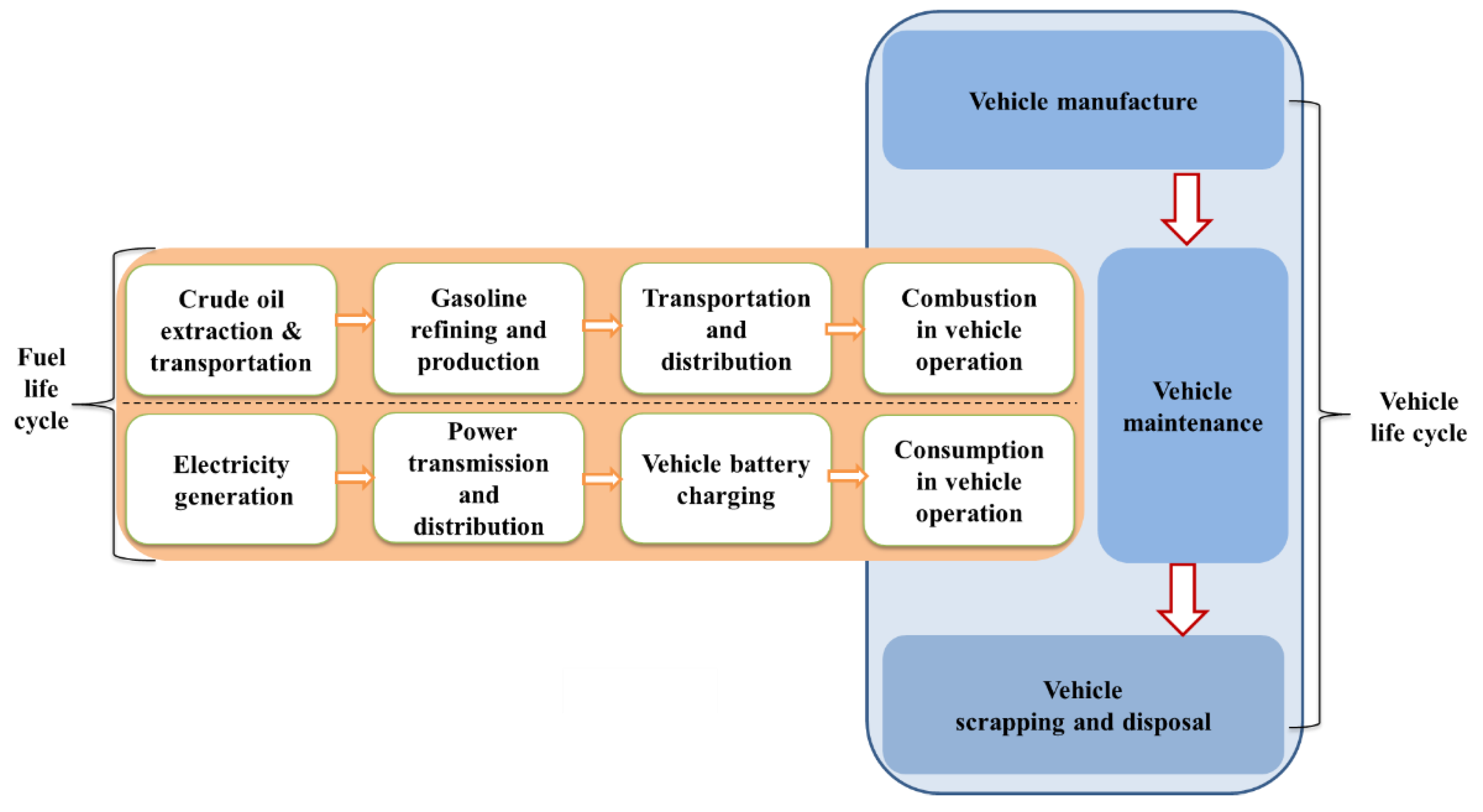
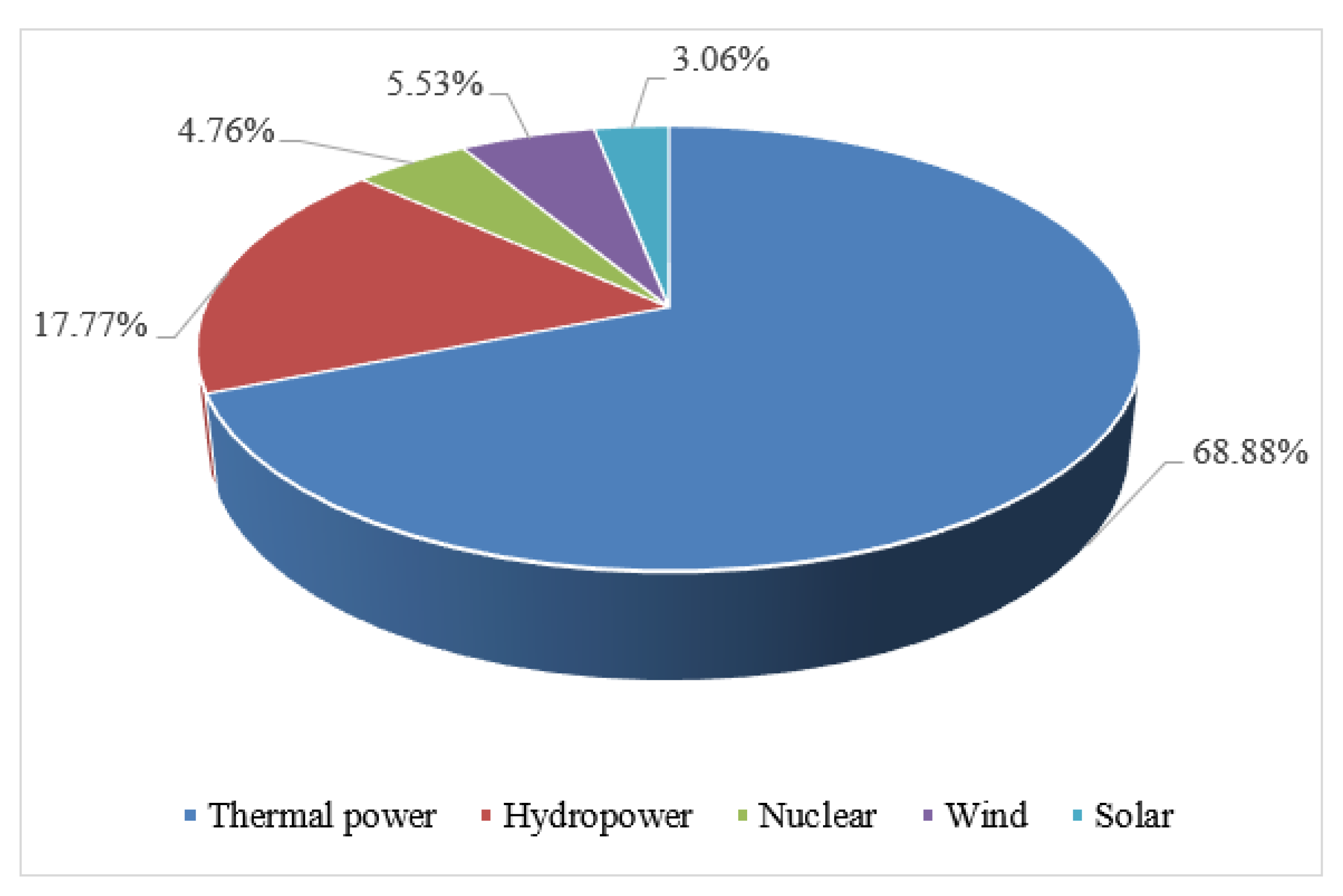
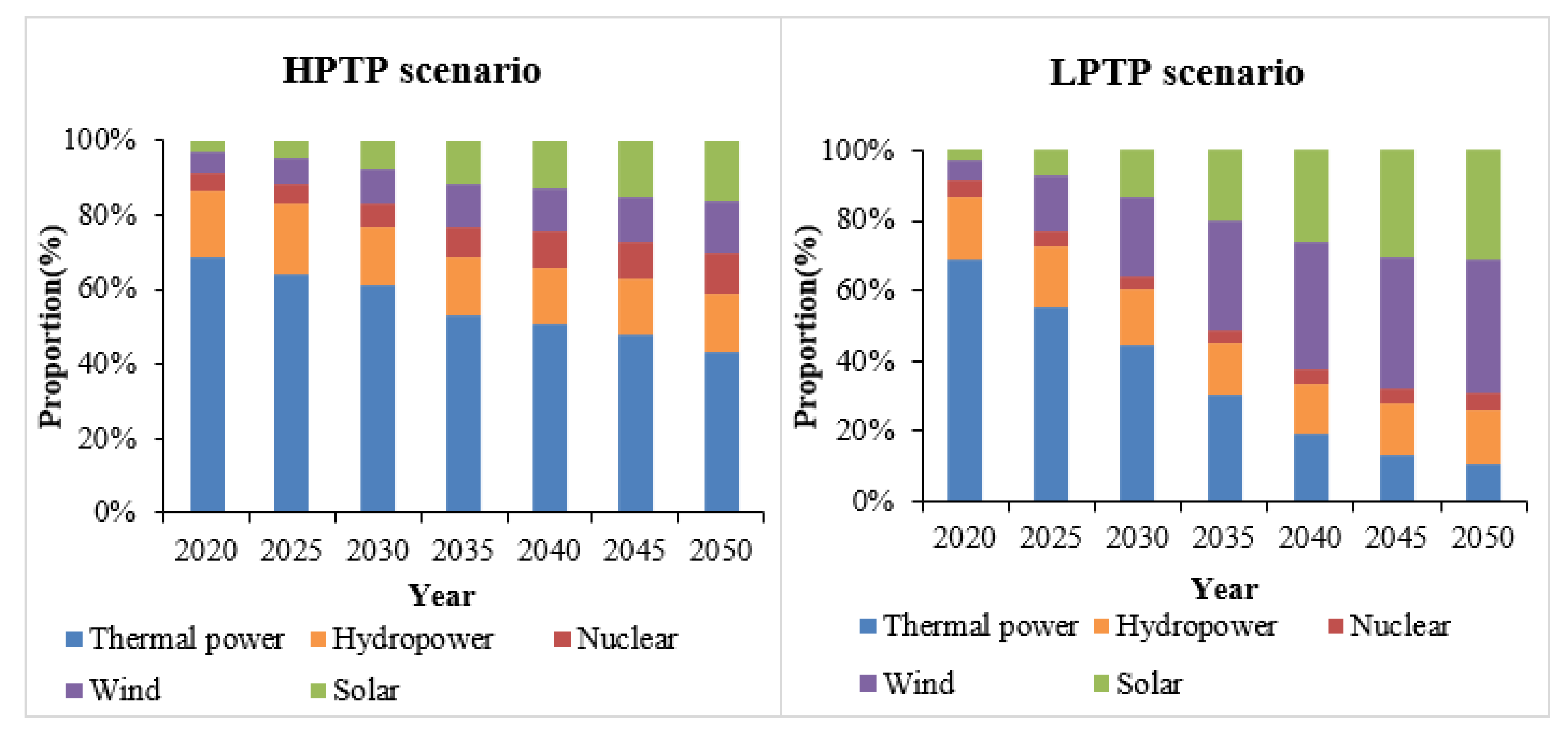
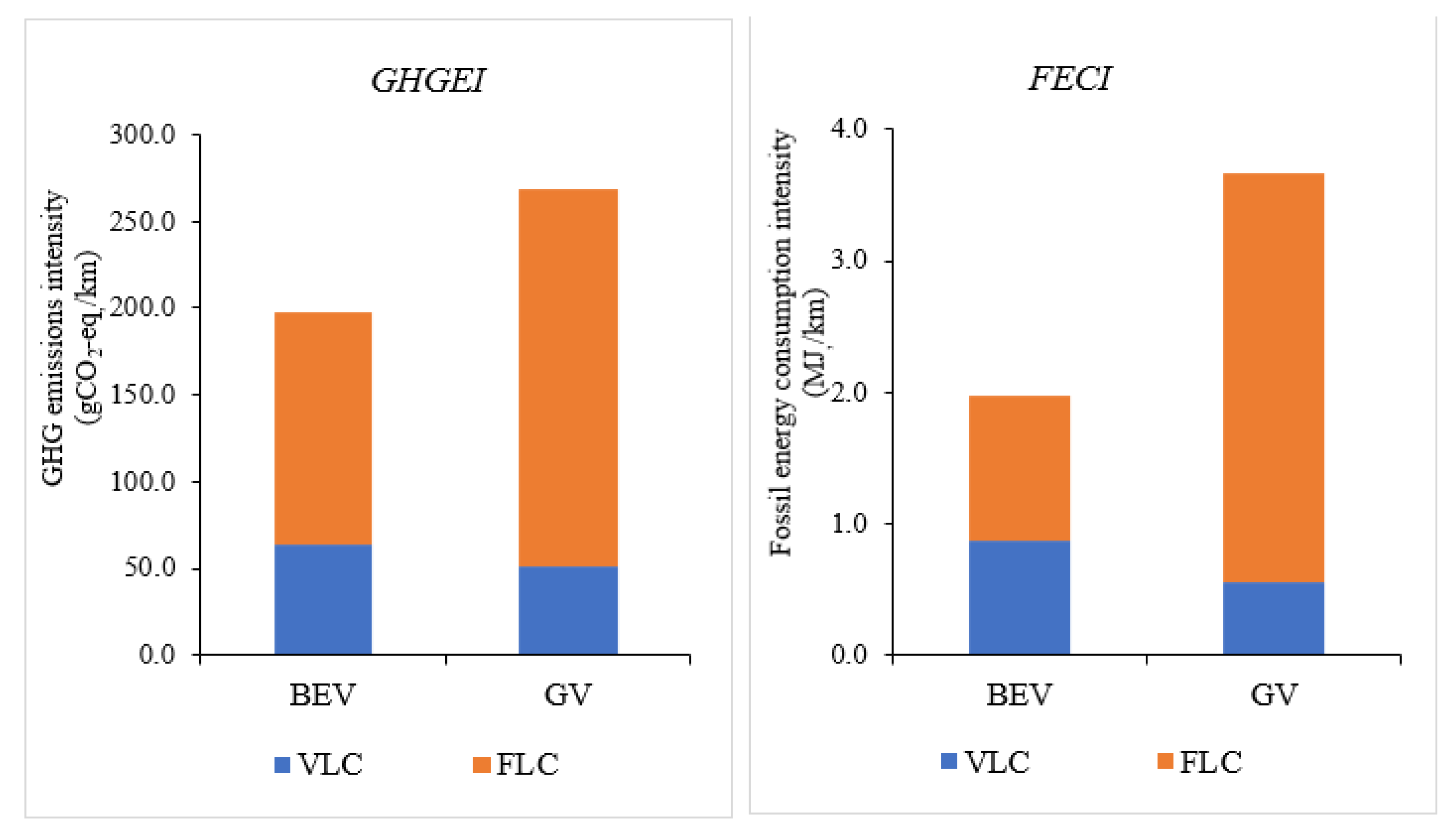
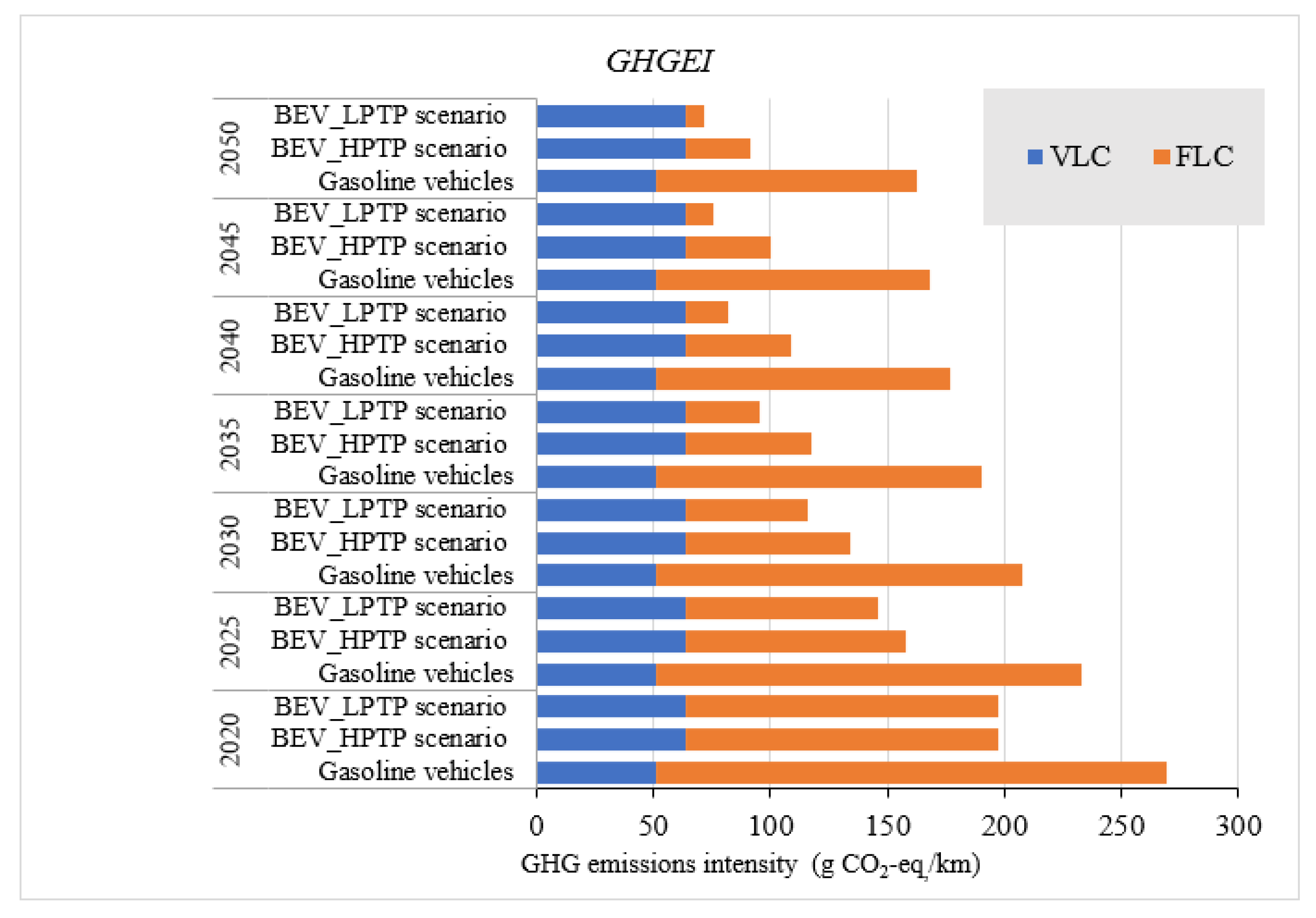
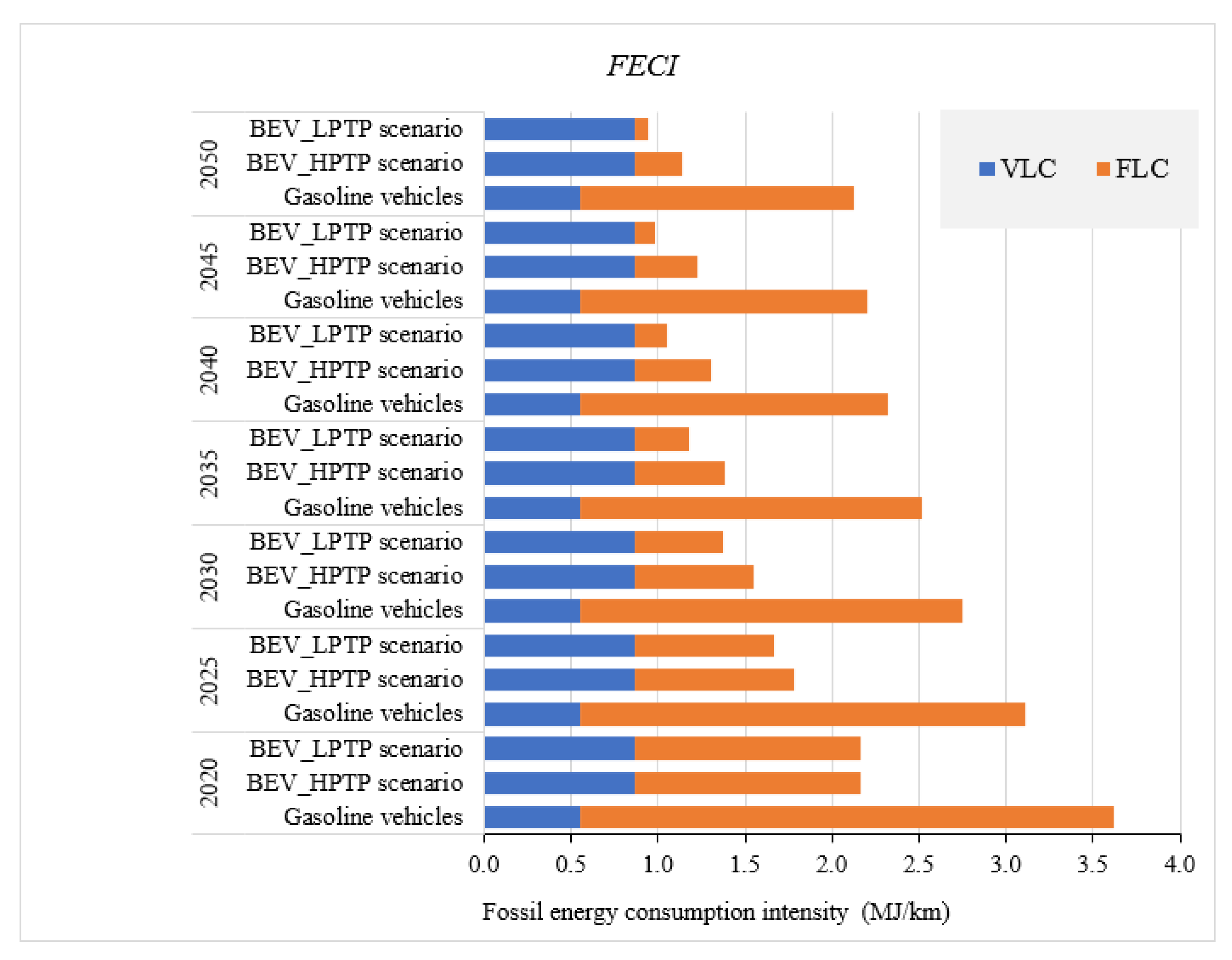
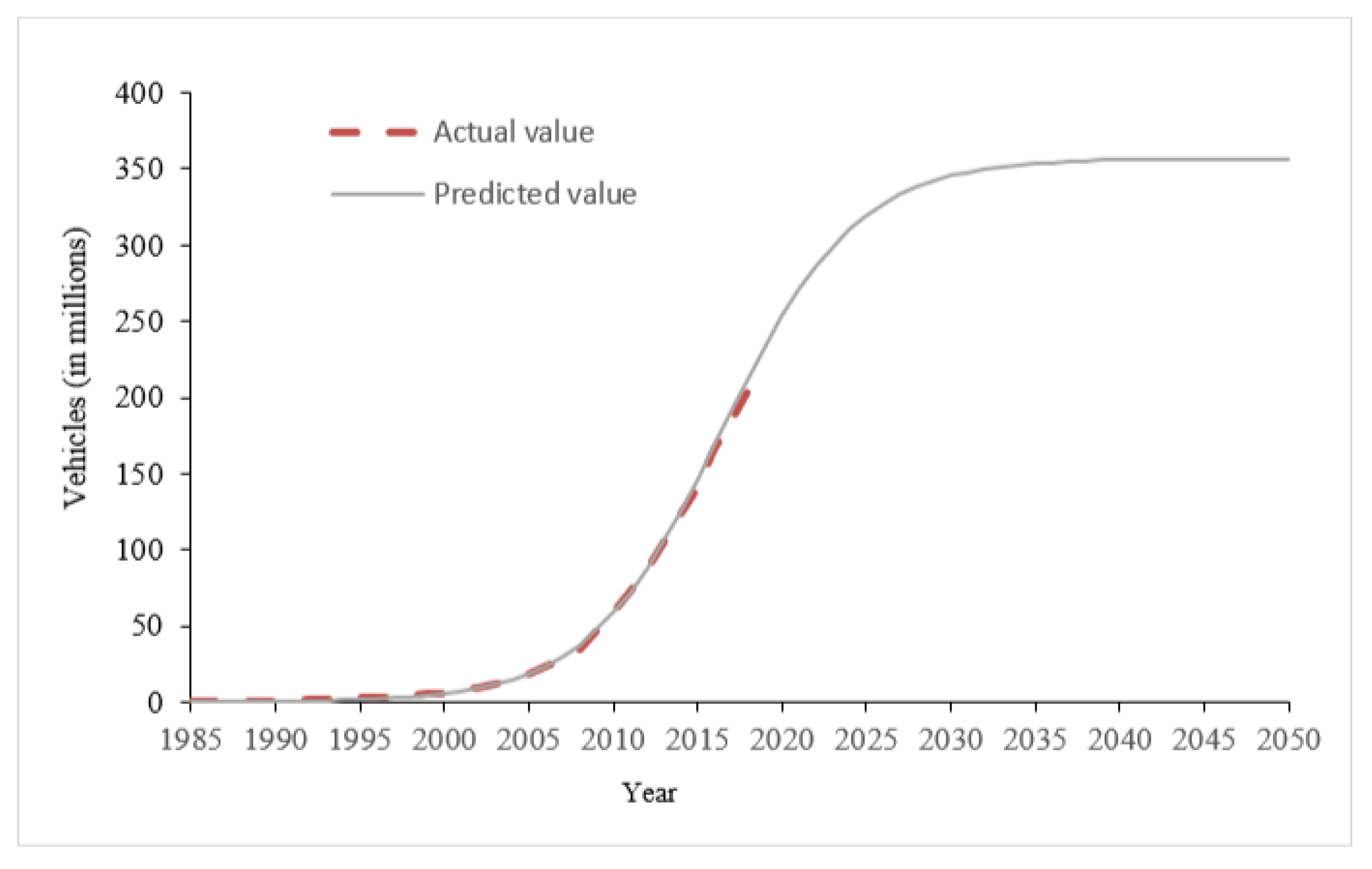
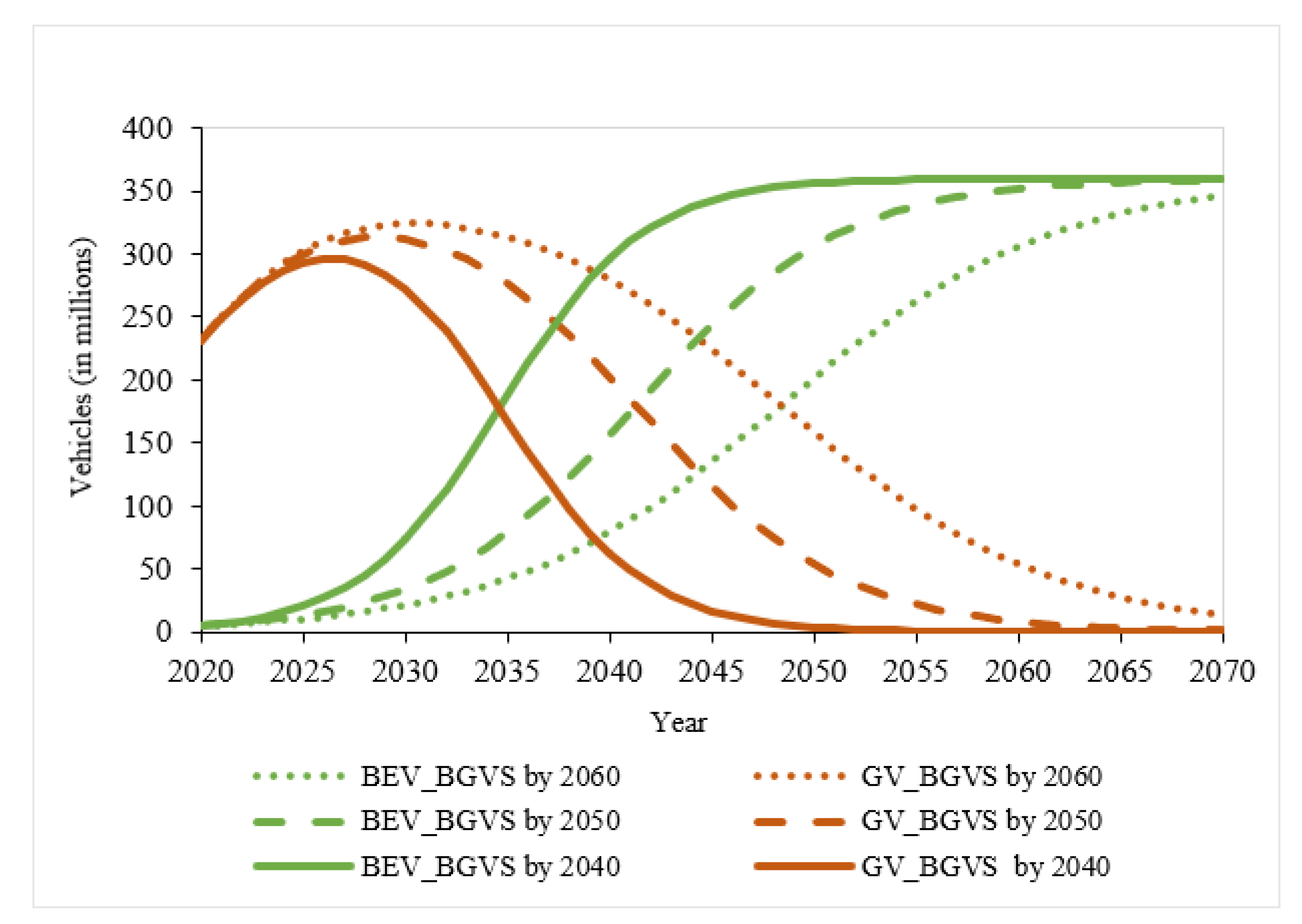
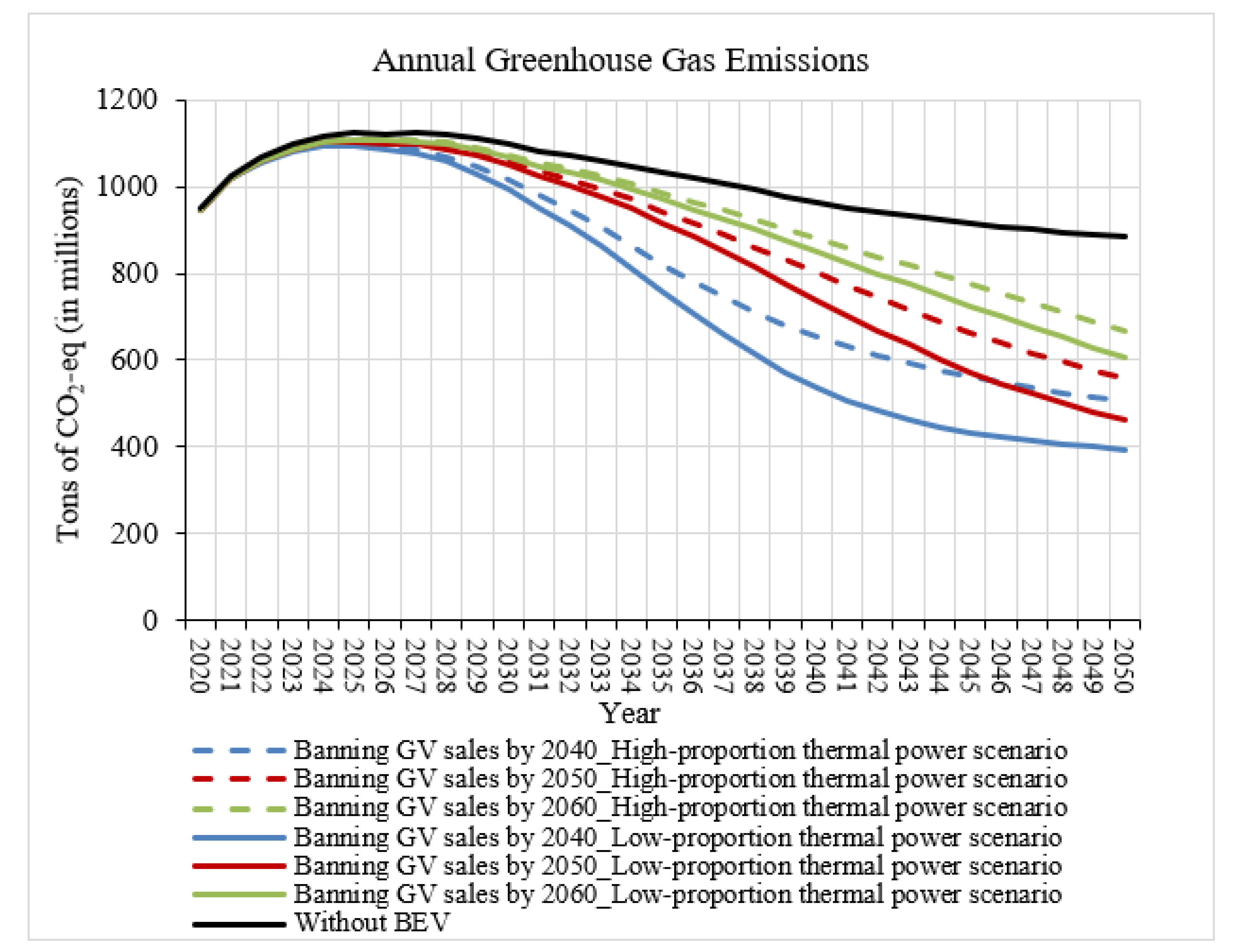

| FECIFP (MJ/kWh) | GHGEIFP (g CO2-eq/kWh) | |
|---|---|---|
| Coal-fired thermal power (CFTP) | 8.97 | 891.5 |
| Hydropower | 0.001 | 18.36 |
| Nuclear power | 0.23 | 23.42 |
| Solar power | 3.42 | 143.56 |
| Wind power | 0.17 | 7.20 |
| Estimated Value | Significance (p-Value) | |
|---|---|---|
| A | 35,691.60 | 0.001 |
| B | 3561.16 | 0.000 |
| C | 0.25 | 0.000 |
| Year | Actual Value (in Millions) | Estimated Value (in Millions) | Error |
|---|---|---|---|
| 2018 | 205.554 | 212.8365 | 3.54% |
| 2019 | 226.35 | 233.8661 | 3.32% |
| 2020 | 243.93 | 253.3203 | 3.85% |
| 2021 | 262.46 | 270.8309 | 3.19% |
Publisher’s Note: MDPI stays neutral with regard to jurisdictional claims in published maps and institutional affiliations. |
© 2022 by the authors. Licensee MDPI, Basel, Switzerland. This article is an open access article distributed under the terms and conditions of the Creative Commons Attribution (CC BY) license (https://creativecommons.org/licenses/by/4.0/).
Share and Cite
Wu, Q.; Sun, S. Energy and Environmental Impact of the Promotion of Battery Electric Vehicles in the Context of Banning Gasoline Vehicle Sales. Energies 2022, 15, 8388. https://doi.org/10.3390/en15228388
Wu Q, Sun S. Energy and Environmental Impact of the Promotion of Battery Electric Vehicles in the Context of Banning Gasoline Vehicle Sales. Energies. 2022; 15(22):8388. https://doi.org/10.3390/en15228388
Chicago/Turabian StyleWu, Qi, and Shouheng Sun. 2022. "Energy and Environmental Impact of the Promotion of Battery Electric Vehicles in the Context of Banning Gasoline Vehicle Sales" Energies 15, no. 22: 8388. https://doi.org/10.3390/en15228388







